An Analysis of Trade Unions' Relevance in the Australian Labour Market
VerifiedAdded on 2021/02/19
|10
|2214
|49
Essay
AI Summary
This essay critically investigates the relevance of trade unions in the Australian labor market. It begins with an introduction defining trade unions and their functions, followed by a literature review on the decline in union membership rates over the past sixty years, and the impact on wage growth. The essay then explores the relationship between trade unions and political parties, particularly the Australian Labour Party and the Liberal and National Party. It examines the impact of industrial relations laws, the changes in negotiation powers for public sector unions, and the relationships of trade unions in the private sector. The analysis includes graphs illustrating membership trends and trend analysis, along with a conclusion summarizing the findings and a list of references.
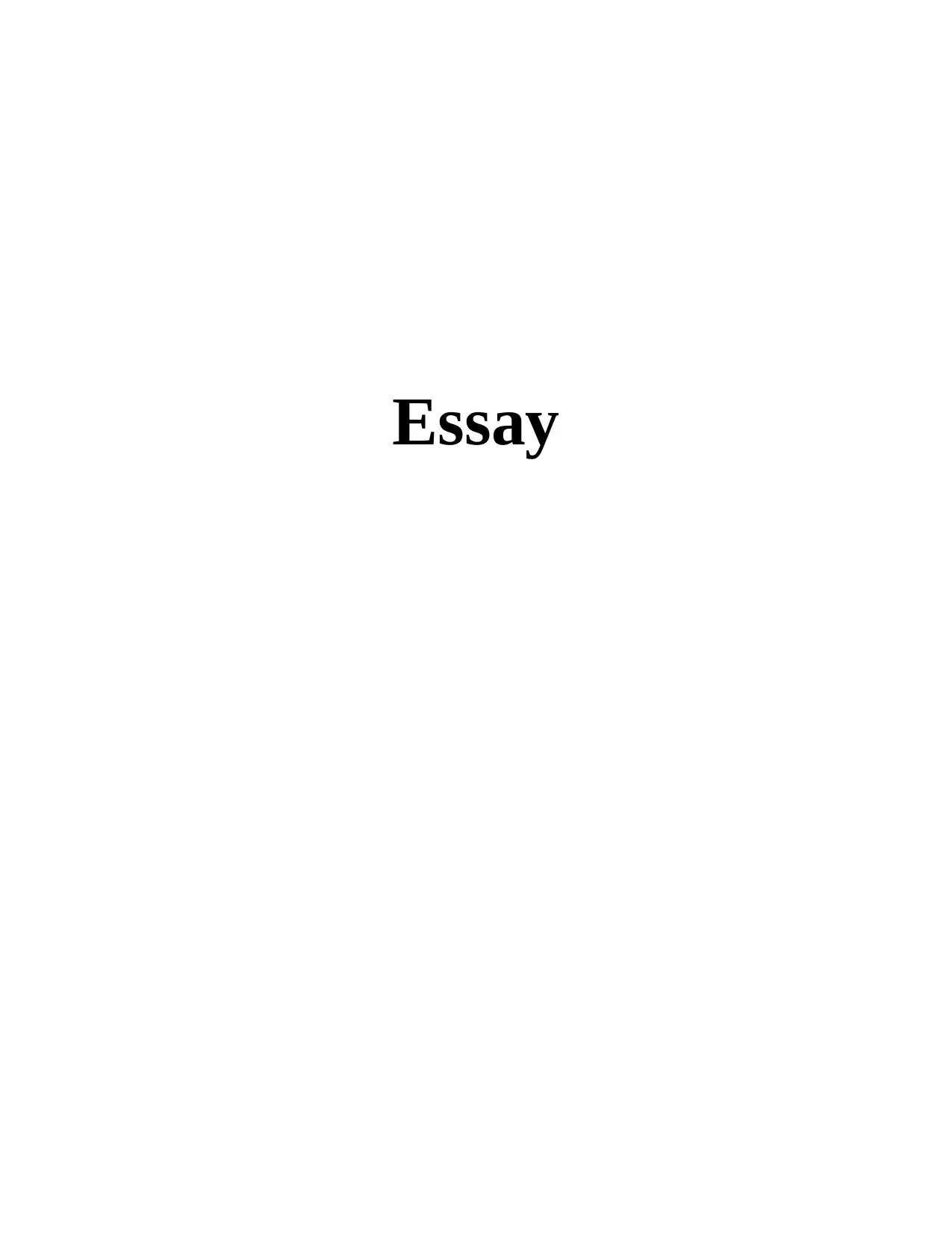
Essay
Paraphrase This Document
Need a fresh take? Get an instant paraphrase of this document with our AI Paraphraser

Table of Contents
TOPIC: Trade unions have lost their relevance in the Australian labor market..............................4
INTRODUCTION...........................................................................................................................4
MAIN BODY...................................................................................................................................4
Literature Review on Decline in Union Membership Rate.........................................................4
Trend of Relationship of Trade Unions With Australian Labour Party and the Liberal and
National Party..............................................................................................................................5
Impact on Industrial Relation Laws by LNP Governments and Impact on Powers of Trade
Unions..........................................................................................................................................5
Changes in Negotiation Powers for Public Sector Trade Unions................................................6
Discussion of Relationships of Trade Unions in Private Sectors in Australia.............................6
Graphs of Membership Over Years Along with Trend Analysis of the Membership Including
Commentaries..............................................................................................................................7
Conduction of Other Research and Analysis...............................................................................8
CONCLUSION..............................................................................................................................11
REFRENCES.................................................................................................................................12
TOPIC: Trade unions have lost their relevance in the Australian labor market..............................4
INTRODUCTION...........................................................................................................................4
MAIN BODY...................................................................................................................................4
Literature Review on Decline in Union Membership Rate.........................................................4
Trend of Relationship of Trade Unions With Australian Labour Party and the Liberal and
National Party..............................................................................................................................5
Impact on Industrial Relation Laws by LNP Governments and Impact on Powers of Trade
Unions..........................................................................................................................................5
Changes in Negotiation Powers for Public Sector Trade Unions................................................6
Discussion of Relationships of Trade Unions in Private Sectors in Australia.............................6
Graphs of Membership Over Years Along with Trend Analysis of the Membership Including
Commentaries..............................................................................................................................7
Conduction of Other Research and Analysis...............................................................................8
CONCLUSION..............................................................................................................................11
REFRENCES.................................................................................................................................12

⊘ This is a preview!⊘
Do you want full access?
Subscribe today to unlock all pages.

Trusted by 1+ million students worldwide
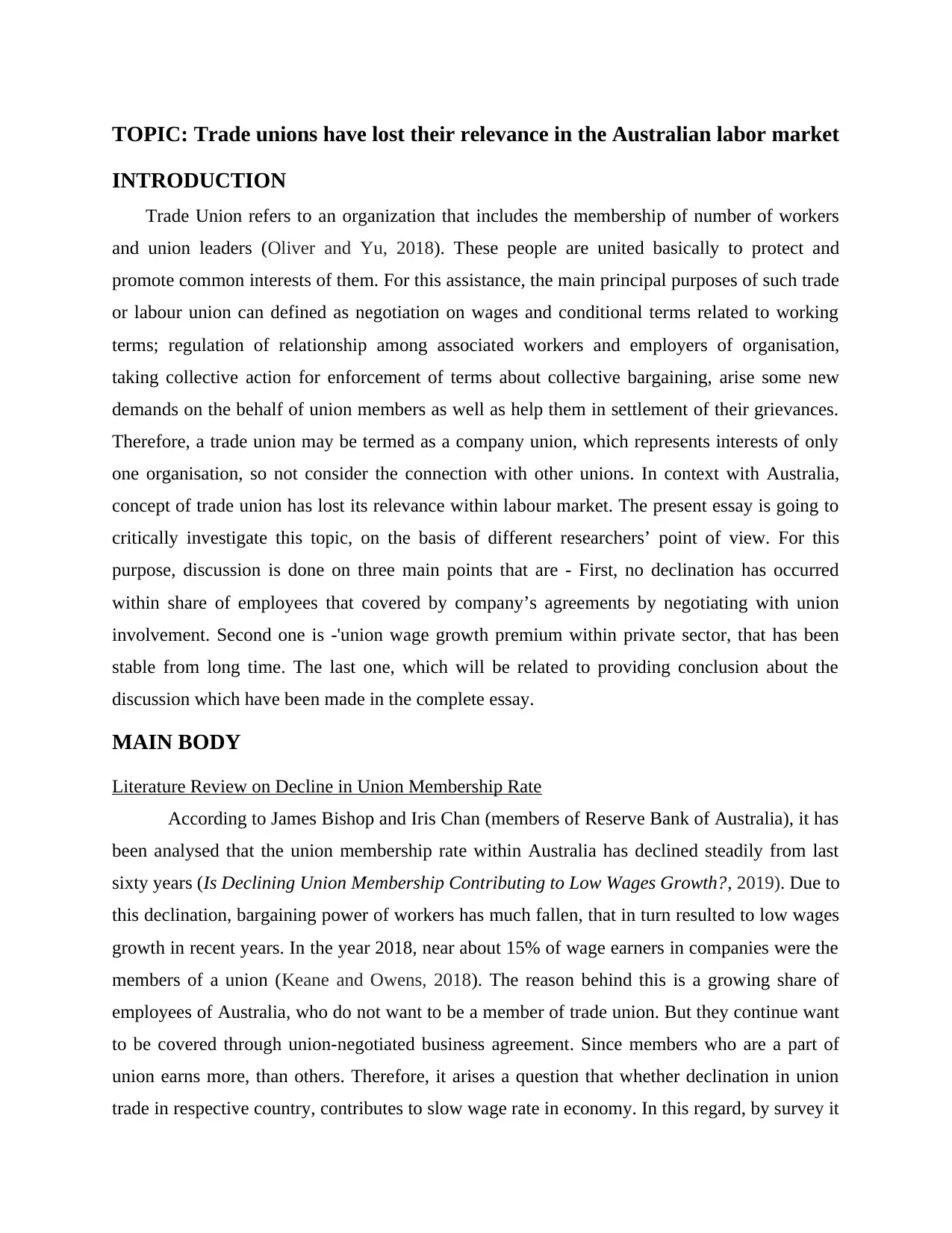
TOPIC: Trade unions have lost their relevance in the Australian labor market
INTRODUCTION
Trade Union refers to an organization that includes the membership of number of workers
and union leaders (Oliver and Yu, 2018). These people are united basically to protect and
promote common interests of them. For this assistance, the main principal purposes of such trade
or labour union can defined as negotiation on wages and conditional terms related to working
terms; regulation of relationship among associated workers and employers of organisation,
taking collective action for enforcement of terms about collective bargaining, arise some new
demands on the behalf of union members as well as help them in settlement of their grievances.
Therefore, a trade union may be termed as a company union, which represents interests of only
one organisation, so not consider the connection with other unions. In context with Australia,
concept of trade union has lost its relevance within labour market. The present essay is going to
critically investigate this topic, on the basis of different researchers’ point of view. For this
purpose, discussion is done on three main points that are - First, no declination has occurred
within share of employees that covered by company’s agreements by negotiating with union
involvement. Second one is -'union wage growth premium within private sector, that has been
stable from long time. The last one, which will be related to providing conclusion about the
discussion which have been made in the complete essay.
MAIN BODY
Literature Review on Decline in Union Membership Rate
According to James Bishop and Iris Chan (members of Reserve Bank of Australia), it has
been analysed that the union membership rate within Australia has declined steadily from last
sixty years (Is Declining Union Membership Contributing to Low Wages Growth?, 2019). Due to
this declination, bargaining power of workers has much fallen, that in turn resulted to low wages
growth in recent years. In the year 2018, near about 15% of wage earners in companies were the
members of a union (Keane and Owens, 2018). The reason behind this is a growing share of
employees of Australia, who do not want to be a member of trade union. But they continue want
to be covered through union-negotiated business agreement. Since members who are a part of
union earns more, than others. Therefore, it arises a question that whether declination in union
trade in respective country, contributes to slow wage rate in economy. In this regard, by survey it
INTRODUCTION
Trade Union refers to an organization that includes the membership of number of workers
and union leaders (Oliver and Yu, 2018). These people are united basically to protect and
promote common interests of them. For this assistance, the main principal purposes of such trade
or labour union can defined as negotiation on wages and conditional terms related to working
terms; regulation of relationship among associated workers and employers of organisation,
taking collective action for enforcement of terms about collective bargaining, arise some new
demands on the behalf of union members as well as help them in settlement of their grievances.
Therefore, a trade union may be termed as a company union, which represents interests of only
one organisation, so not consider the connection with other unions. In context with Australia,
concept of trade union has lost its relevance within labour market. The present essay is going to
critically investigate this topic, on the basis of different researchers’ point of view. For this
purpose, discussion is done on three main points that are - First, no declination has occurred
within share of employees that covered by company’s agreements by negotiating with union
involvement. Second one is -'union wage growth premium within private sector, that has been
stable from long time. The last one, which will be related to providing conclusion about the
discussion which have been made in the complete essay.
MAIN BODY
Literature Review on Decline in Union Membership Rate
According to James Bishop and Iris Chan (members of Reserve Bank of Australia), it has
been analysed that the union membership rate within Australia has declined steadily from last
sixty years (Is Declining Union Membership Contributing to Low Wages Growth?, 2019). Due to
this declination, bargaining power of workers has much fallen, that in turn resulted to low wages
growth in recent years. In the year 2018, near about 15% of wage earners in companies were the
members of a union (Keane and Owens, 2018). The reason behind this is a growing share of
employees of Australia, who do not want to be a member of trade union. But they continue want
to be covered through union-negotiated business agreement. Since members who are a part of
union earns more, than others. Therefore, it arises a question that whether declination in union
trade in respective country, contributes to slow wage rate in economy. In this regard, by survey it
Paraphrase This Document
Need a fresh take? Get an instant paraphrase of this document with our AI Paraphraser
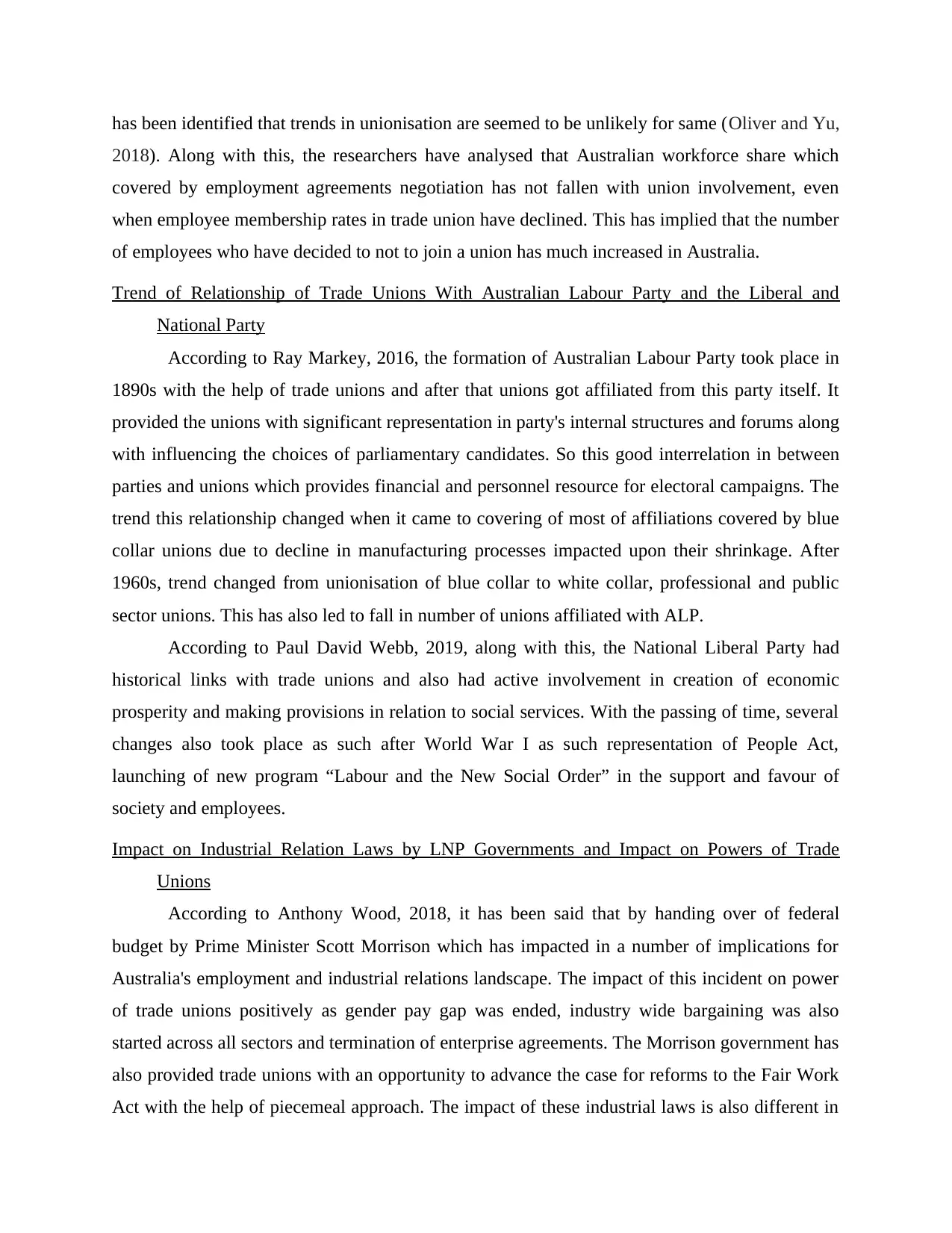
has been identified that trends in unionisation are seemed to be unlikely for same (Oliver and Yu,
2018). Along with this, the researchers have analysed that Australian workforce share which
covered by employment agreements negotiation has not fallen with union involvement, even
when employee membership rates in trade union have declined. This has implied that the number
of employees who have decided to not to join a union has much increased in Australia.
Trend of Relationship of Trade Unions With Australian Labour Party and the Liberal and
National Party
According to Ray Markey, 2016, the formation of Australian Labour Party took place in
1890s with the help of trade unions and after that unions got affiliated from this party itself. It
provided the unions with significant representation in party's internal structures and forums along
with influencing the choices of parliamentary candidates. So this good interrelation in between
parties and unions which provides financial and personnel resource for electoral campaigns. The
trend this relationship changed when it came to covering of most of affiliations covered by blue
collar unions due to decline in manufacturing processes impacted upon their shrinkage. After
1960s, trend changed from unionisation of blue collar to white collar, professional and public
sector unions. This has also led to fall in number of unions affiliated with ALP.
According to Paul David Webb, 2019, along with this, the National Liberal Party had
historical links with trade unions and also had active involvement in creation of economic
prosperity and making provisions in relation to social services. With the passing of time, several
changes also took place as such after World War I as such representation of People Act,
launching of new program “Labour and the New Social Order” in the support and favour of
society and employees.
Impact on Industrial Relation Laws by LNP Governments and Impact on Powers of Trade
Unions
According to Anthony Wood, 2018, it has been said that by handing over of federal
budget by Prime Minister Scott Morrison which has impacted in a number of implications for
Australia's employment and industrial relations landscape. The impact of this incident on power
of trade unions positively as gender pay gap was ended, industry wide bargaining was also
started across all sectors and termination of enterprise agreements. The Morrison government has
also provided trade unions with an opportunity to advance the case for reforms to the Fair Work
Act with the help of piecemeal approach. The impact of these industrial laws is also different in
2018). Along with this, the researchers have analysed that Australian workforce share which
covered by employment agreements negotiation has not fallen with union involvement, even
when employee membership rates in trade union have declined. This has implied that the number
of employees who have decided to not to join a union has much increased in Australia.
Trend of Relationship of Trade Unions With Australian Labour Party and the Liberal and
National Party
According to Ray Markey, 2016, the formation of Australian Labour Party took place in
1890s with the help of trade unions and after that unions got affiliated from this party itself. It
provided the unions with significant representation in party's internal structures and forums along
with influencing the choices of parliamentary candidates. So this good interrelation in between
parties and unions which provides financial and personnel resource for electoral campaigns. The
trend this relationship changed when it came to covering of most of affiliations covered by blue
collar unions due to decline in manufacturing processes impacted upon their shrinkage. After
1960s, trend changed from unionisation of blue collar to white collar, professional and public
sector unions. This has also led to fall in number of unions affiliated with ALP.
According to Paul David Webb, 2019, along with this, the National Liberal Party had
historical links with trade unions and also had active involvement in creation of economic
prosperity and making provisions in relation to social services. With the passing of time, several
changes also took place as such after World War I as such representation of People Act,
launching of new program “Labour and the New Social Order” in the support and favour of
society and employees.
Impact on Industrial Relation Laws by LNP Governments and Impact on Powers of Trade
Unions
According to Anthony Wood, 2018, it has been said that by handing over of federal
budget by Prime Minister Scott Morrison which has impacted in a number of implications for
Australia's employment and industrial relations landscape. The impact of this incident on power
of trade unions positively as gender pay gap was ended, industry wide bargaining was also
started across all sectors and termination of enterprise agreements. The Morrison government has
also provided trade unions with an opportunity to advance the case for reforms to the Fair Work
Act with the help of piecemeal approach. The impact of these industrial laws is also different in
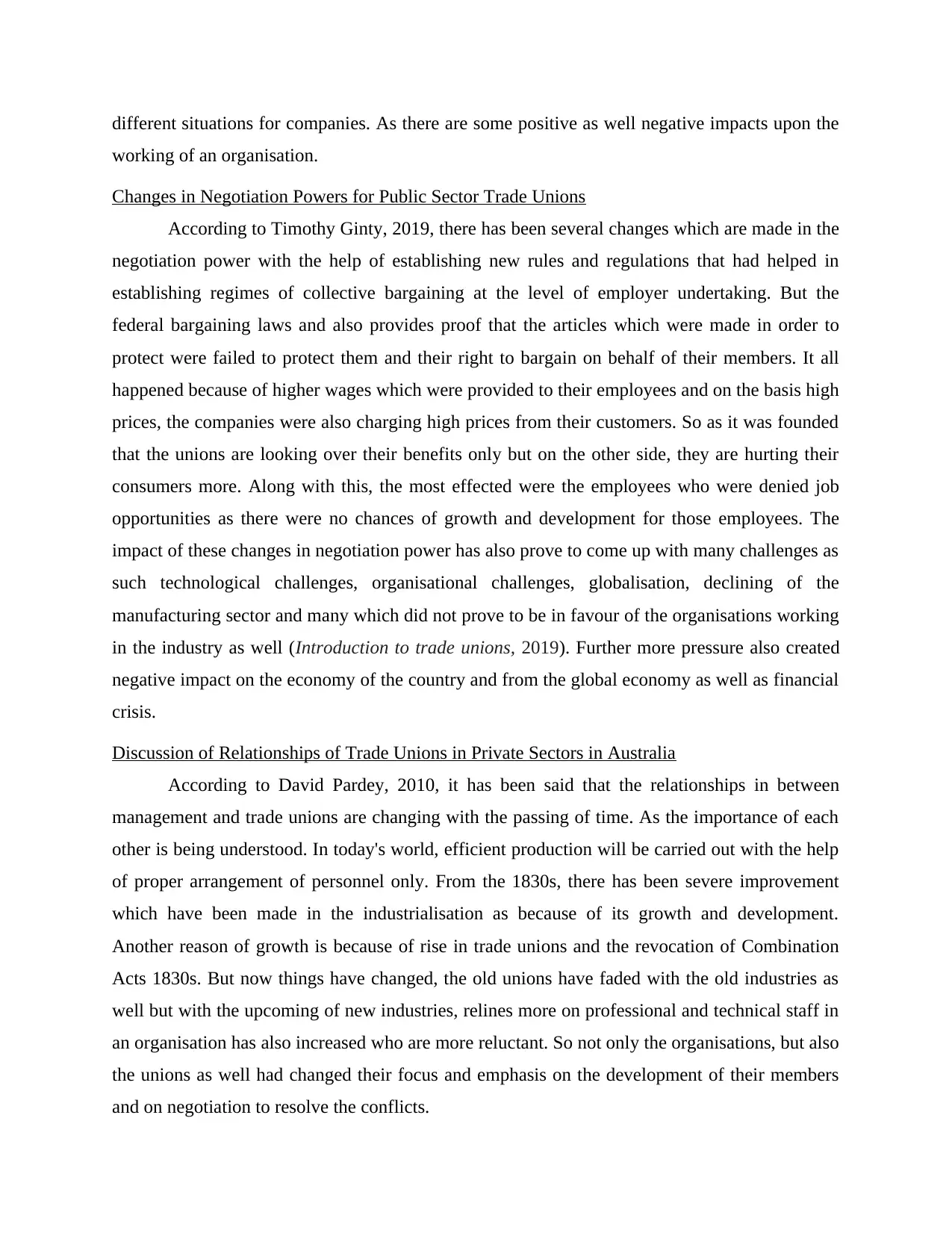
different situations for companies. As there are some positive as well negative impacts upon the
working of an organisation.
Changes in Negotiation Powers for Public Sector Trade Unions
According to Timothy Ginty, 2019, there has been several changes which are made in the
negotiation power with the help of establishing new rules and regulations that had helped in
establishing regimes of collective bargaining at the level of employer undertaking. But the
federal bargaining laws and also provides proof that the articles which were made in order to
protect were failed to protect them and their right to bargain on behalf of their members. It all
happened because of higher wages which were provided to their employees and on the basis high
prices, the companies were also charging high prices from their customers. So as it was founded
that the unions are looking over their benefits only but on the other side, they are hurting their
consumers more. Along with this, the most effected were the employees who were denied job
opportunities as there were no chances of growth and development for those employees. The
impact of these changes in negotiation power has also prove to come up with many challenges as
such technological challenges, organisational challenges, globalisation, declining of the
manufacturing sector and many which did not prove to be in favour of the organisations working
in the industry as well (Introduction to trade unions, 2019). Further more pressure also created
negative impact on the economy of the country and from the global economy as well as financial
crisis.
Discussion of Relationships of Trade Unions in Private Sectors in Australia
According to David Pardey, 2010, it has been said that the relationships in between
management and trade unions are changing with the passing of time. As the importance of each
other is being understood. In today's world, efficient production will be carried out with the help
of proper arrangement of personnel only. From the 1830s, there has been severe improvement
which have been made in the industrialisation as because of its growth and development.
Another reason of growth is because of rise in trade unions and the revocation of Combination
Acts 1830s. But now things have changed, the old unions have faded with the old industries as
well but with the upcoming of new industries, relines more on professional and technical staff in
an organisation has also increased who are more reluctant. So not only the organisations, but also
the unions as well had changed their focus and emphasis on the development of their members
and on negotiation to resolve the conflicts.
working of an organisation.
Changes in Negotiation Powers for Public Sector Trade Unions
According to Timothy Ginty, 2019, there has been several changes which are made in the
negotiation power with the help of establishing new rules and regulations that had helped in
establishing regimes of collective bargaining at the level of employer undertaking. But the
federal bargaining laws and also provides proof that the articles which were made in order to
protect were failed to protect them and their right to bargain on behalf of their members. It all
happened because of higher wages which were provided to their employees and on the basis high
prices, the companies were also charging high prices from their customers. So as it was founded
that the unions are looking over their benefits only but on the other side, they are hurting their
consumers more. Along with this, the most effected were the employees who were denied job
opportunities as there were no chances of growth and development for those employees. The
impact of these changes in negotiation power has also prove to come up with many challenges as
such technological challenges, organisational challenges, globalisation, declining of the
manufacturing sector and many which did not prove to be in favour of the organisations working
in the industry as well (Introduction to trade unions, 2019). Further more pressure also created
negative impact on the economy of the country and from the global economy as well as financial
crisis.
Discussion of Relationships of Trade Unions in Private Sectors in Australia
According to David Pardey, 2010, it has been said that the relationships in between
management and trade unions are changing with the passing of time. As the importance of each
other is being understood. In today's world, efficient production will be carried out with the help
of proper arrangement of personnel only. From the 1830s, there has been severe improvement
which have been made in the industrialisation as because of its growth and development.
Another reason of growth is because of rise in trade unions and the revocation of Combination
Acts 1830s. But now things have changed, the old unions have faded with the old industries as
well but with the upcoming of new industries, relines more on professional and technical staff in
an organisation has also increased who are more reluctant. So not only the organisations, but also
the unions as well had changed their focus and emphasis on the development of their members
and on negotiation to resolve the conflicts.
⊘ This is a preview!⊘
Do you want full access?
Subscribe today to unlock all pages.

Trusted by 1+ million students worldwide
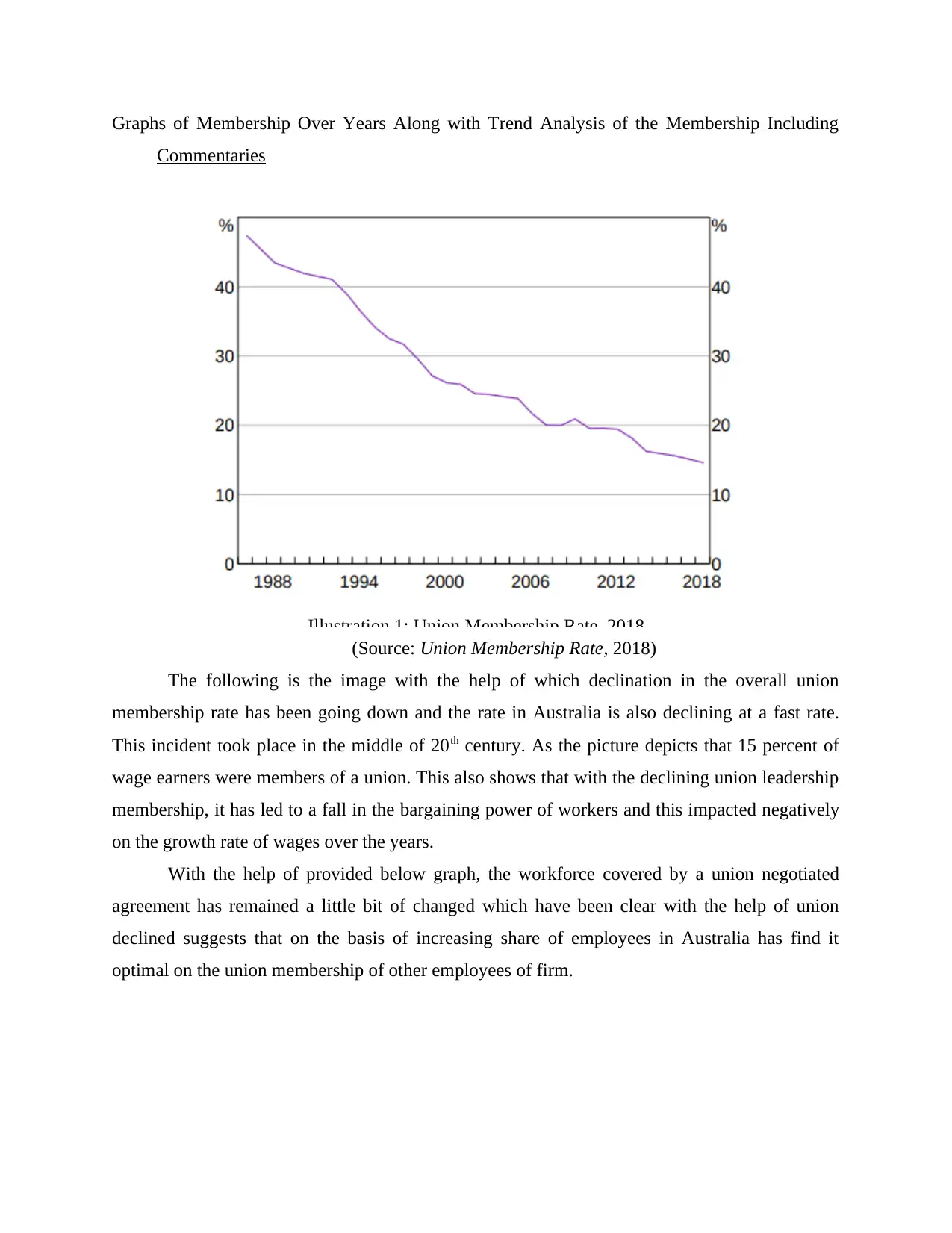
Graphs of Membership Over Years Along with Trend Analysis of the Membership Including
Commentaries
(Source: Union Membership Rate, 2018)
The following is the image with the help of which declination in the overall union
membership rate has been going down and the rate in Australia is also declining at a fast rate.
This incident took place in the middle of 20th century. As the picture depicts that 15 percent of
wage earners were members of a union. This also shows that with the declining union leadership
membership, it has led to a fall in the bargaining power of workers and this impacted negatively
on the growth rate of wages over the years.
With the help of provided below graph, the workforce covered by a union negotiated
agreement has remained a little bit of changed which have been clear with the help of union
declined suggests that on the basis of increasing share of employees in Australia has find it
optimal on the union membership of other employees of firm.
Illustration 1: Union Membership Rate, 2018
Commentaries
(Source: Union Membership Rate, 2018)
The following is the image with the help of which declination in the overall union
membership rate has been going down and the rate in Australia is also declining at a fast rate.
This incident took place in the middle of 20th century. As the picture depicts that 15 percent of
wage earners were members of a union. This also shows that with the declining union leadership
membership, it has led to a fall in the bargaining power of workers and this impacted negatively
on the growth rate of wages over the years.
With the help of provided below graph, the workforce covered by a union negotiated
agreement has remained a little bit of changed which have been clear with the help of union
declined suggests that on the basis of increasing share of employees in Australia has find it
optimal on the union membership of other employees of firm.
Illustration 1: Union Membership Rate, 2018
Paraphrase This Document
Need a fresh take? Get an instant paraphrase of this document with our AI Paraphraser
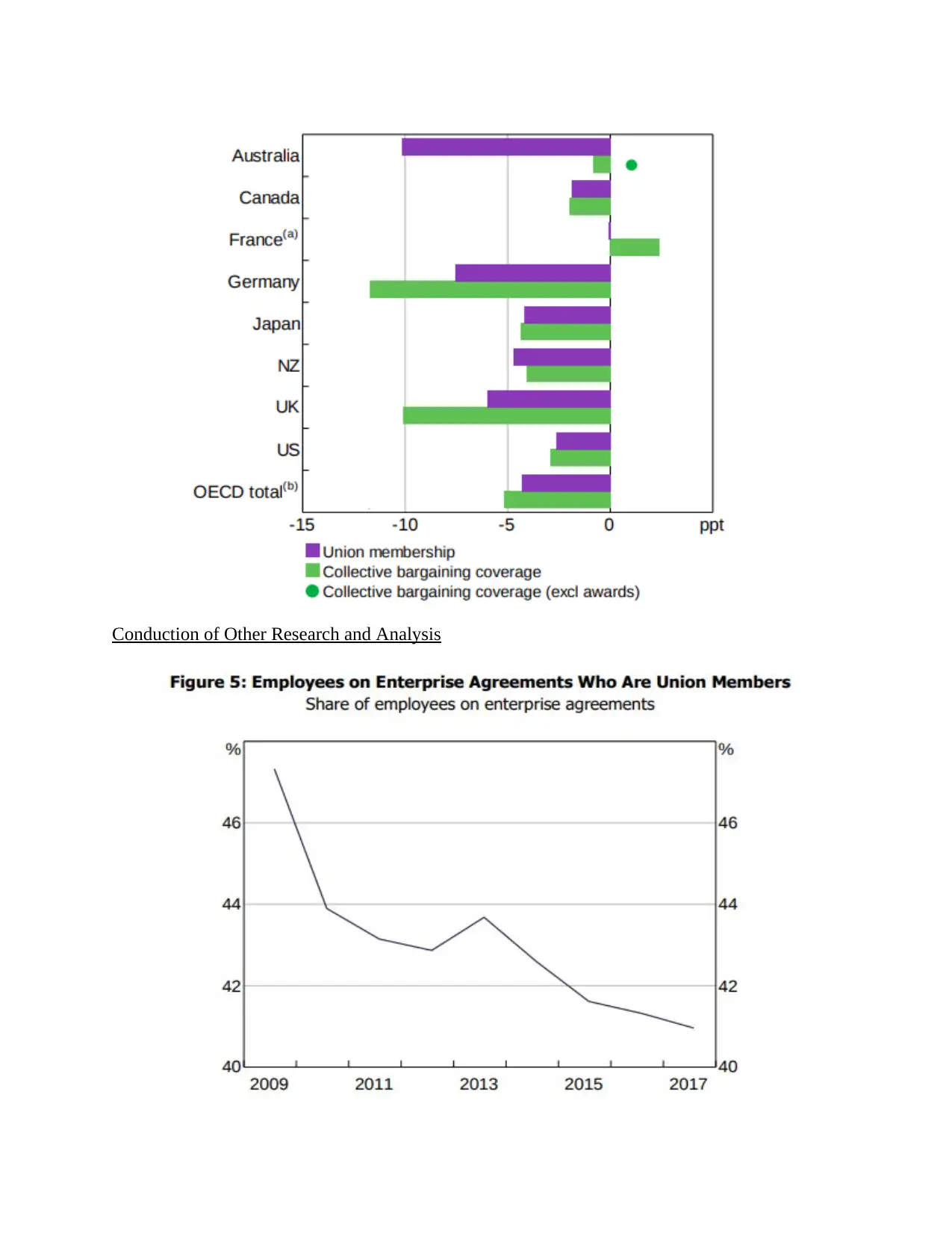
Conduction of Other Research and Analysis
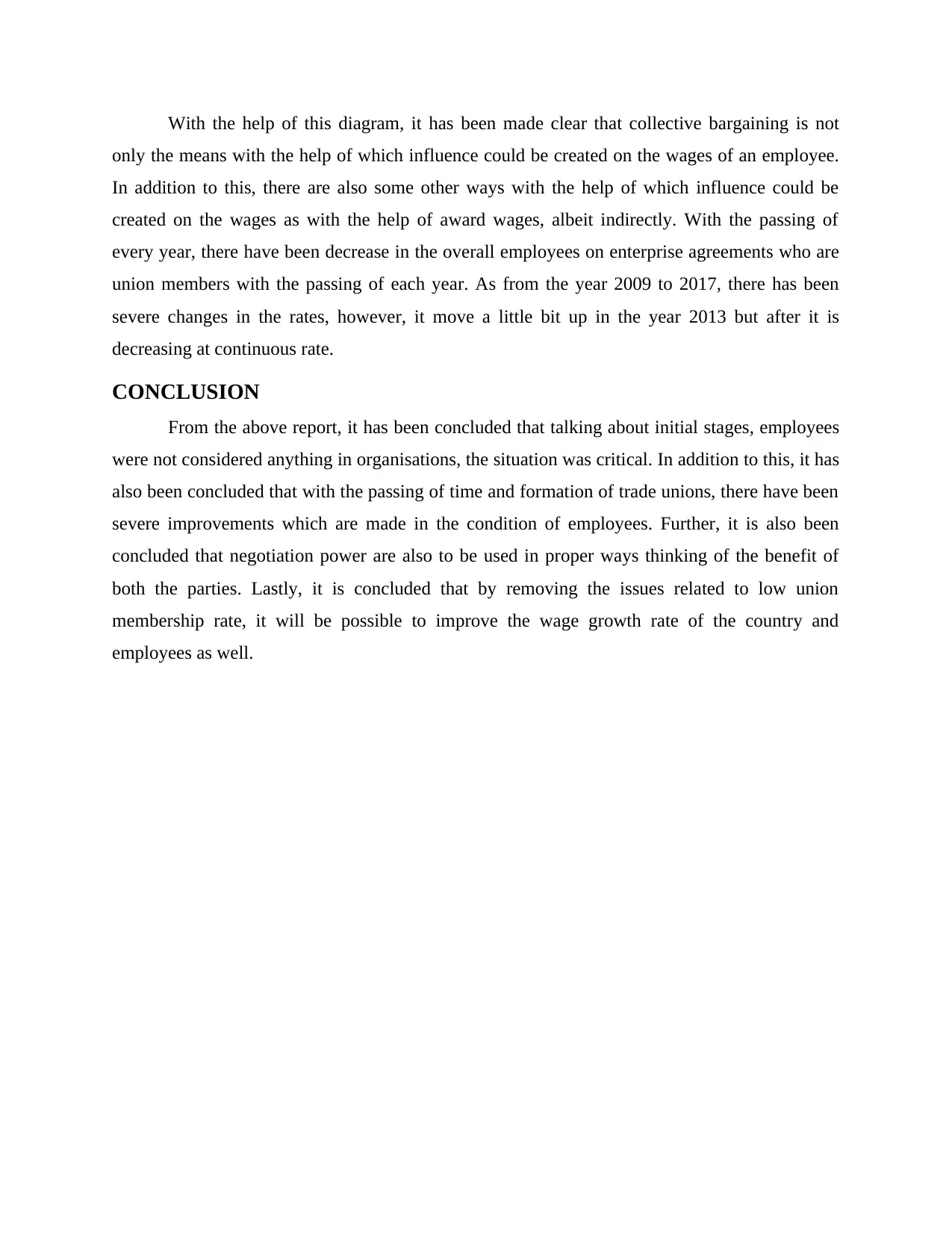
With the help of this diagram, it has been made clear that collective bargaining is not
only the means with the help of which influence could be created on the wages of an employee.
In addition to this, there are also some other ways with the help of which influence could be
created on the wages as with the help of award wages, albeit indirectly. With the passing of
every year, there have been decrease in the overall employees on enterprise agreements who are
union members with the passing of each year. As from the year 2009 to 2017, there has been
severe changes in the rates, however, it move a little bit up in the year 2013 but after it is
decreasing at continuous rate.
CONCLUSION
From the above report, it has been concluded that talking about initial stages, employees
were not considered anything in organisations, the situation was critical. In addition to this, it has
also been concluded that with the passing of time and formation of trade unions, there have been
severe improvements which are made in the condition of employees. Further, it is also been
concluded that negotiation power are also to be used in proper ways thinking of the benefit of
both the parties. Lastly, it is concluded that by removing the issues related to low union
membership rate, it will be possible to improve the wage growth rate of the country and
employees as well.
only the means with the help of which influence could be created on the wages of an employee.
In addition to this, there are also some other ways with the help of which influence could be
created on the wages as with the help of award wages, albeit indirectly. With the passing of
every year, there have been decrease in the overall employees on enterprise agreements who are
union members with the passing of each year. As from the year 2009 to 2017, there has been
severe changes in the rates, however, it move a little bit up in the year 2013 but after it is
decreasing at continuous rate.
CONCLUSION
From the above report, it has been concluded that talking about initial stages, employees
were not considered anything in organisations, the situation was critical. In addition to this, it has
also been concluded that with the passing of time and formation of trade unions, there have been
severe improvements which are made in the condition of employees. Further, it is also been
concluded that negotiation power are also to be used in proper ways thinking of the benefit of
both the parties. Lastly, it is concluded that by removing the issues related to low union
membership rate, it will be possible to improve the wage growth rate of the country and
employees as well.
⊘ This is a preview!⊘
Do you want full access?
Subscribe today to unlock all pages.

Trusted by 1+ million students worldwide
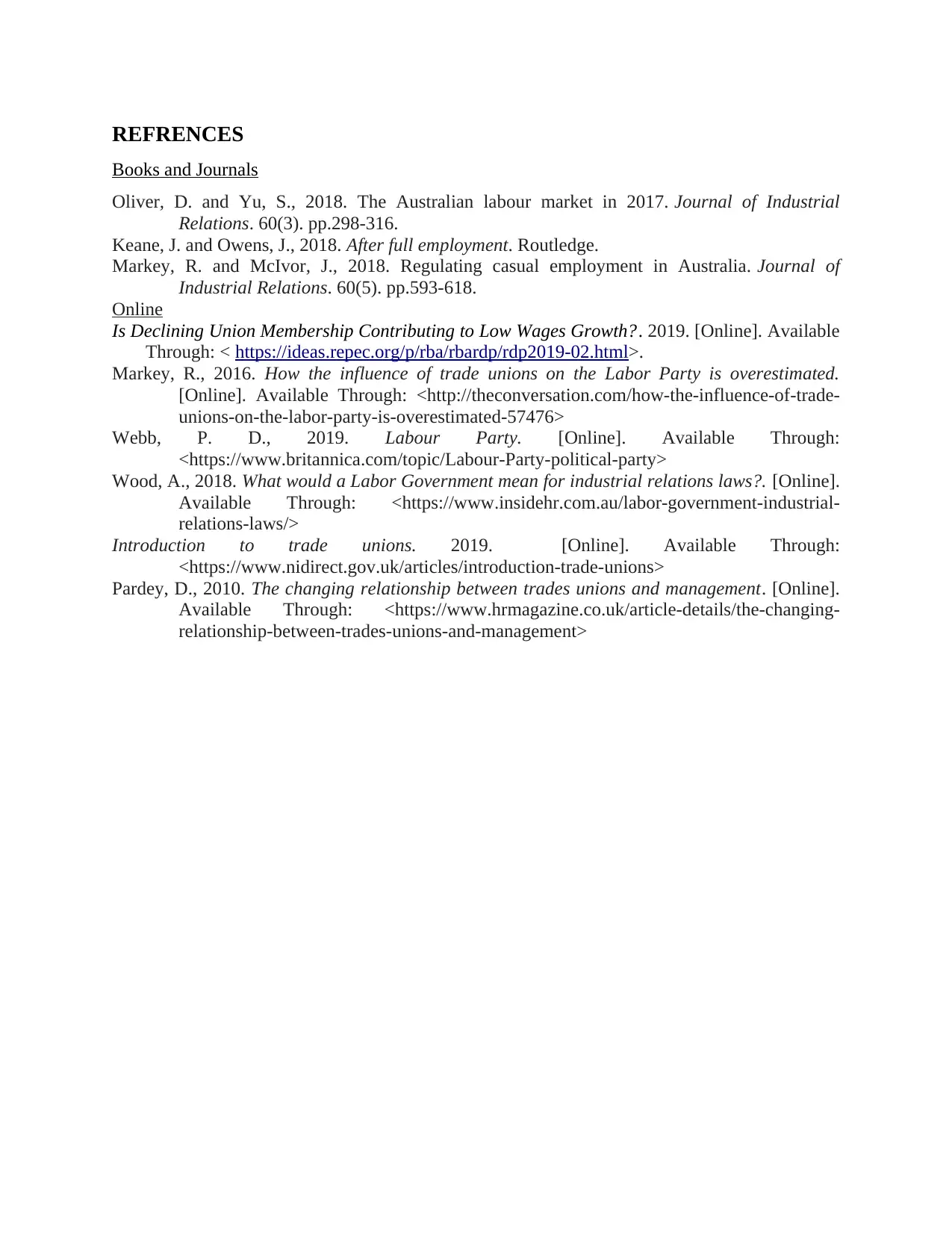
REFRENCES
Books and Journals
Oliver, D. and Yu, S., 2018. The Australian labour market in 2017. Journal of Industrial
Relations. 60(3). pp.298-316.
Keane, J. and Owens, J., 2018. After full employment. Routledge.
Markey, R. and McIvor, J., 2018. Regulating casual employment in Australia. Journal of
Industrial Relations. 60(5). pp.593-618.
Online
Is Declining Union Membership Contributing to Low Wages Growth?. 2019. [Online]. Available
Through: < https://ideas.repec.org/p/rba/rbardp/rdp2019-02.html>.
Markey, R., 2016. How the influence of trade unions on the Labor Party is overestimated.
[Online]. Available Through: <http://theconversation.com/how-the-influence-of-trade-
unions-on-the-labor-party-is-overestimated-57476>
Webb, P. D., 2019. Labour Party. [Online]. Available Through:
<https://www.britannica.com/topic/Labour-Party-political-party>
Wood, A., 2018. What would a Labor Government mean for industrial relations laws?. [Online].
Available Through: <https://www.insidehr.com.au/labor-government-industrial-
relations-laws/>
Introduction to trade unions. 2019. [Online]. Available Through:
<https://www.nidirect.gov.uk/articles/introduction-trade-unions>
Pardey, D., 2010. The changing relationship between trades unions and management. [Online].
Available Through: <https://www.hrmagazine.co.uk/article-details/the-changing-
relationship-between-trades-unions-and-management>
Books and Journals
Oliver, D. and Yu, S., 2018. The Australian labour market in 2017. Journal of Industrial
Relations. 60(3). pp.298-316.
Keane, J. and Owens, J., 2018. After full employment. Routledge.
Markey, R. and McIvor, J., 2018. Regulating casual employment in Australia. Journal of
Industrial Relations. 60(5). pp.593-618.
Online
Is Declining Union Membership Contributing to Low Wages Growth?. 2019. [Online]. Available
Through: < https://ideas.repec.org/p/rba/rbardp/rdp2019-02.html>.
Markey, R., 2016. How the influence of trade unions on the Labor Party is overestimated.
[Online]. Available Through: <http://theconversation.com/how-the-influence-of-trade-
unions-on-the-labor-party-is-overestimated-57476>
Webb, P. D., 2019. Labour Party. [Online]. Available Through:
<https://www.britannica.com/topic/Labour-Party-political-party>
Wood, A., 2018. What would a Labor Government mean for industrial relations laws?. [Online].
Available Through: <https://www.insidehr.com.au/labor-government-industrial-
relations-laws/>
Introduction to trade unions. 2019. [Online]. Available Through:
<https://www.nidirect.gov.uk/articles/introduction-trade-unions>
Pardey, D., 2010. The changing relationship between trades unions and management. [Online].
Available Through: <https://www.hrmagazine.co.uk/article-details/the-changing-
relationship-between-trades-unions-and-management>
1 out of 10
Related Documents
Your All-in-One AI-Powered Toolkit for Academic Success.
+13062052269
info@desklib.com
Available 24*7 on WhatsApp / Email
![[object Object]](/_next/static/media/star-bottom.7253800d.svg)
Unlock your academic potential
Copyright © 2020–2025 A2Z Services. All Rights Reserved. Developed and managed by ZUCOL.



